The Americas lost most of their giant beasts when a wave of extinction swept them between the twelfth and the eighth millennia BC. Precisely what caused this cataclysm remains a source of controversy. That said, humans appear to have expanded their range of settlement in the Western Hemisphere around this time, so it is likely we had at least a hand in the matter.
At any rate, amongst the victims of the prehistoric American extinction pulse were the giant ground sloths, a highly successful group once found from Patagonia to the Great Lakes. Yet the ground sloths’ final curtain did not come down in the eighth millennium BC. Colossi such as Megatherium americanum might have vanished, but on a series of refugia, remnants persisted. The last ground sloths still wandered Caribbean forests around the time that Ancient Egypt’s first pyramids were raised. These animals were much smaller than their lost relatives. The biggest, such as Megalocnus rodens of Cuba, were comparable in size to a large sheep.

Detail of a Megatherium americanum skeleton cast, Natural History Museum, London. Image: Matt Stanfield, 2018
The Caribbean islands are thought to have lost at least seven sloth species in the last nine thousand years, with at least one within the last five thousand. It is believed the end of the ground sloths was precipitated by human settlement in the Caribbean, six thousand years or more ago. Certainly, few ground sloth remains have been carbon-dated to times much beyond the earliest evidence of humans on their islands.
The relative proximity of these creatures’ last days to our own time fascinates me. Compared to their continental kin, the Antillean sloths are obscure, with restorations of their life appearance hard to come by. Wanting to develop my understanding of these peculiar leftovers, I decided to try a life reconstruction of one such sloth. I selected Acratocnus ye, whose scientific name translates into English as “yesterday’s powerless sloth”. Taxonomists can be very cruel…
A. ye, though tiny compared to titans like Megatherium, was not as hapless as its name suggests. Standing on its hind legs, the solidly-built sloth reached a respectable metre or so in height. This is far in excess of the roughly guinea pig-sized Hispaniolan hutia, the biggest native mammal species remaining in A. ye’s former range.
The obscurity of Acratocnus ye meant I could only find a few pictures of subfossil bones and a medium-resolution image of a complete skeleton for reference. This limited supply of visual references suited me well. I prefer reconstructing obscure animals because not only does uncertainty give me more room for imagination, but, on a more prosaic note, the fewer total drawings of a species that exist, the fewer better drawings than mine there are likely to be! Below is a sketch of the skeletal photo which I used as the main reference for my piece (I think the original image is copyrighted, hence the reproduction).

Sketch of a reconstructed Acratocnus ye skeleton, Matt Stanfield, 2018
Reconstructions of recently-extinct species are not only a learning experience for me, but an emotive one. Working on these pieces forces close consideration of those anatomical details that define an animal’s appearance. This process, I find, infuses a personal notion of the organism’s essence into my memory. It actually has a vaguely devotional feel to it, since I usually feel more attached, in some way, to creatures which I have drawn, as opposed to those I have not.
In the case of ground sloths, the matter of the animals’ “essence” is a challenging one to address. If you wanted to reconstruct the life appearance of say, a sabre cat or mastodon, there are living creatures which provide a viable reference point. Less so for ground sloths. Contemporary tree sloths are highly adapted to an idiosyncratic lifestyle, meaning that even the smaller ground sloths had a markedly different external appearance to their arboreal relatives. Thus, I aimed to give my Acratocnus a “look” distinct from extant animals.

Acratocnus ye, Matt Stanfield, 2017
Ground sloths being tricky to pin down visually, I found that the Acratocnus ye on my page passed through various “looks”. Initially, the stocky legs and long tail gave the lost mammal taking shape on the page a kangaroo-like aspect. The addition of a barrel-shaped torso conjured up thoughts of a bear standing on its hind legs. When it came time to cap off the Acratocnus, it took some work to stop the head from (unexpectedly) resembling an otter’s.
After dozens of hours, the piece was complete. Sadly, due to the technique which I used, it doesn’t photograph brilliantly. Be assured though that thousands of individually-drawn hairs went into the pelt, not to mention the time taken on claws, eyes, muzzle and ears. Whilst I’m finally satisfied enough with my tribute to A. ye to make it public, there are various snags I was unable to fully rectify. Firstly, the limited reference material caused me some confusion regarding the sloth’s feet (which is why they aren’t shown). Second, not having a scale for the species, for most of the drawing process I envisaged A. ye as about double its actual size. Resultantly, my ground sloth has a bit more heft than it perhaps should. Lastly, I somewhat lazily portrayed Acratocnus ye in a very over-used pose for ground sloths: rearing up and leaning on a tree. There’s no excuse for my repeating of this tired trope. Nevertheless, I hope that you enjoy my visual salute to a virtually unknown animal that vanished on the very cusp of the historical era.
Matt Stanfield
With reference to Cooke, Dávalos, Mychajliw, Turvey & Upham, ‘Anthropogenic Extinction Dominates Holocene Decline of West Indian Mammals’, in Annual Review of Ecology, Evolution and Systematics. August 23, 2017. 48:301-27. Consulted at https://www.annualreviews.org/doi/abs/10.1146/annurev-ecolsys-110316-022754
With thanks to Mo Hassan of https://www.mocoillustration.com for help with translation of A. ye’s binomial
